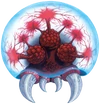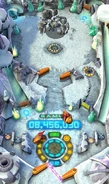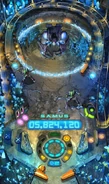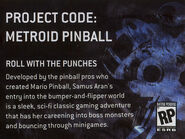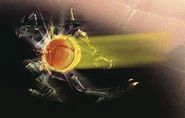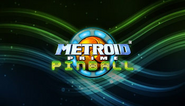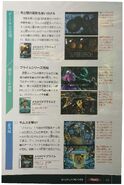| This is a featured article. |
| This article is written from the Real Life point of view |
Metroid Prime Pinball (メトロイドプライムピンボール Metoroido Puraimu Pinbōru) is a pinball-themed game in the Metroid series. The game uses the graphical style and various story elements from Metroid Prime. It was developed by Fuse Games, the developers of Mario Pinball Land for the Game Boy Advance. The game has received generally favorable reviews, holding a 79% at Metacritic[1] and an 82% at Game Rankings.[2] It was compatible and comes bundled with a Nintendo DS Rumble Pak.
Story[]
There is no explicit storyline in the game. However, events are loosely based on the plot from the first Metroid Prime, where the player must acquire 12 Chozo Artifacts, gain access to the Artifact Temple, and finally defeat Metroid Prime in both its forms. Metroid Prime Pinball can simply be seen as a pinball game with a Metroid Prime theme, like the various real pinball machines with themes based on various franchises.
Gameplay[]
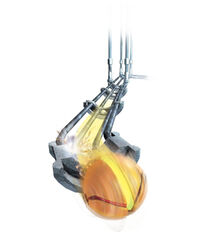
Metroid Prime Pinball plays much like a normal pinball game. There is an assortment of typical pinball items including flippers, spinners, bumpers, and ramps. Pinball also adds quite a few new mechanics to the classic pinball formula that can't exist in real pinball, such as enemies that wander around the table, wall-jumping, shooting, and colored targets that can only be dropped by hitting them with the same-color balls.
Samus herself serves as the ball in the game in her Morph Ball form. Sliding the touch screen can be used to "nudge" the pinball machine and alter the direction in which Samus can go. Multiball is available as two-ball Phazon-generated colored clones of Samus, along with up to three regular Samus clone balls. Samus can also get out of her Morph Ball form on the bottom screen, and is controlled via the touch screen, rotating her left and right to aim her Arm Cannon at enemies.
Tables[]
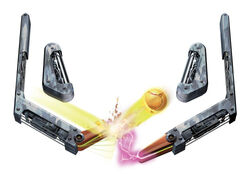
The main game consists of six tables, all of which are based upon areas from Metroid Prime. The game begins with two tables available for play. The Pirate Frigate and Tallon Overworld tables serve as the main source of Chozo Artifacts, where they are awarded as prizes for completing objectives. Access to two more tables is granted upon activating all the objectives within either table. Completion of these objectives is not necessary to move on.
In the next two tables, Phendrana Drifts and Phazon Mines, the player acquires a new ability on each table, along with battling a large boss creature. This boss is the source of one Chozo Artifact, and victory is required to move on to the next table.
Completing any objective will earn an artifact unless ten artifacts have already been acquired from completing objectives, in which case a special will be awarded instead of an artifact. A special is worth 50,000 points like an artifact but does not count toward the artifact total.
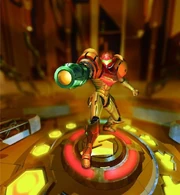
Twelve artifacts are required to access the Artifact Temple. This table is unique in that the player is given a 6-ball multiball, and losing all the balls does not detract from the extra balls. To complete this table, the player must hit twelve different targets scattered throughout the table, while being bombarded from above by Meta Ridley. If all of the balls are lost in any way, by draining off the table or being destroyed by Meta Ridley, the table immediately ends. While none of the twelve artifacts collected will be lost, players will be forced to go back to a different table and complete it before being allowed another attempt at the Artifact Temple.
Upon completing the Artifact Temple, access is granted to the final table, The Impact Crater, where the final ability, the Force Ball, is held. The only objective on this table is killing Metroid Prime. Once this objective has been completed, the game starts again with in a harder difficulty, all the tables are available for single-table play, and expert mode is unlocked.
The first two levels contain game modes that are able to be activated through various methods. These include "Gunship Multiball," "Clone Multiball," "Phazon Multiball," "Parasite Purge," "Burrower Bash," "Shriekbat Shootout," "Beetle Blast," "Metroid Mania," "Phazon Frenzy," "Space Pirate Panic," "Triclops Terror," "Wall Jump," and "Hurry Up".
Development[]
Please help improve this article or section by expanding it.
Much more information can be added to this article.
Development of Pinball commenced shortly after production of Fuse's previous game, Mario Pinball Land, was finished. Nintendo, and Kensuke Tanabe in particular, were interested in making another game based on a different property, Metroid. Retro Studios, the developers of the mainline Metroid Prime series, provided 3D models from Metroid Prime to Fuse, while Nintendo provided software development kits and funding to Fuse. Their financial stake granted Nintendo a great deal of input in the direction of Pinball. Even still, they trusted Fuse founder Adrian Barritt and the team to develop the game with minimal resistance.[3] Other than providing art and audio assets, Retro Studios had very little involvement with the game's development.[4]
Each table was designed by the four artists working on Pinball in collaboration, with Barritt designing their flow. They began with the two main tables of the Pirate Frigate and Tallon Overworld. All tables would feature inlanes, bumpers and flippers, and the team went through several prototypes to address the gap between the two screens of the Nintendo DS. The physics were adjusted so that the Morph Ball would cross this gap faster than it was actually moving. Compared to the Frigate and Overworld, the rest of the tables were less complicated, but the design process was identical.
The base of each table was a "grey table", with which Fuse Games could test the gameplay flow and ensure it was possible to launch the ball. Upon completion of these tests, the art team would conceptualize the table's design, and consider which enemies from Metroid Prime to include. Flashing Lights were placed on the tables to indicate what type of shot to make, another aspect Barritt was responsible for.
Due to hardware limitations, Pinball was created to use pre-rendered images as the levels, but with 3D physics and a reduced number of colors. Bosses were designed with inspiration from their Metroid Prime counterparts (coupled with artistic liberties), emphasizing their attacks since the player is limited in what they can do as a ball.
While Fuse Games discussed making pinball games based on other Nintendo franchises, a sequel to Metroid Prime Pinball was never considered.[3]
Multiplayer[]
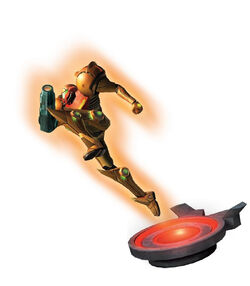
The multiplayer option requires only one copy of the game and allows for up to 8 players to compete in a race to reach a target score. This mode uses a seventh table, Magmoor Caverns, which is not playable in single-player. The multiplayer mode can be played in a practice mode with only one player simply by selecting the start game option without any other players being on the downloads list.
Trivia[]
- The game is considered by some fans to be the spiritual successor of Galactic Pinball for the Nintendo Virtual Boy. This is because both are space-themed pinball games and both are Metroid themed, as Samus appears in a mini-game on the Cosmic stage of Galactic Pinball.
- Some players have spotted a cow flying on the top of the screen during gameplay. Interestingly, a cow can sometimes be found in many pinball games as an Easter egg.
- The Pirate Frigate's background music is a remix of the original Brinstar's, whereas the "Parasite Purge" and "Triclops Terror" minigames feature the theme from the Hive Mecha and Incinerator Drone minibosses. The former was also later reused in Super Smash Bros. Brawl, although a narration by Jay Ward was added.
- The title and Game Over themes are actually from Metroid Prime 2: Echoes. Samus also has the Seeker Missile (without the seeking), Screw Attack, and Wall Jump from Echoes, which did not feature in the Prime this game is based on.
- The theme for Clone, Phazon and Gunship Multiball is the Hunters theme and is also from Echoes.
- There is no table based on the Chozo Ruins, making it the only Tallon IV area to not be represented.
- The game was playable in 2005 during the Nintendo Fusion Tour.
- A gallery of merchandise can be found here: [1]
- The game's credits can be found here, and an archive of a developer interview for the game can be found here.
- Metroid Prime Pinball, Metroid II: Return of Samus, Metroid Prime: Federation Force and Metroid Dread are the only Metroid games without a published English strategy guide. A couple of Japanese guides for Metroid II were released, however, and partial walkthroughs of it are found in issues 31 and 37 of Nintendo Power.
- In Japan, the game sold 0 copies on its launch week, reaching a total of 15,541 units sold lifetime there.[5]
See also[]
Gallery[]
References[]
- ^ Metroid Prime Pinball (ds: 2005). Metacritic. Retrieved on 2007-04-04.
- ^ Metroid Prime Pinball Reviews. Game Rankings. Retrieved on 2007-04-04.
- ^ a b Shinesparkers. Interview: Matthew Nightingale. May 20, 2023. Retrieved May 20, 2023. https://shinesparkers.net/interviews/matthew-nightingale/
- ^ Interview: Bryan Walker. Shinesparkers. May 6, 2022. Retrieved May 6, 2022.
- ^ http://www.neogaf.com/forum/showpost.php?p=215431386&postcount=16

